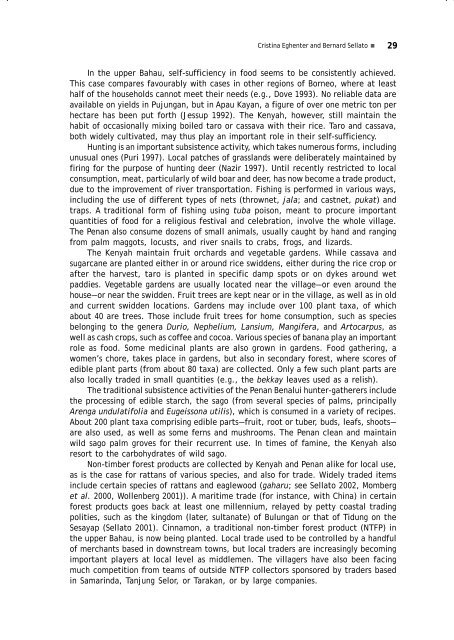Social science research and conservation management in the ...
Social science research and conservation management in the ...
Social science research and conservation management in the ...
Create successful ePaper yourself
Turn your PDF publications into a flip-book with our unique Google optimized e-Paper software.
Crist<strong>in</strong>a Eghenter <strong>and</strong> Bernard Sellato<br />
In <strong>the</strong> upper Bahau, self-sufficiency <strong>in</strong> food seems to be consistently achieved.<br />
This case compares favourably with cases <strong>in</strong> o<strong>the</strong>r regions of Borneo, where at least<br />
half of <strong>the</strong> households cannot meet <strong>the</strong>ir needs (e.g., Dove 1993). No reliable data are<br />
available on yields <strong>in</strong> Pujungan, but <strong>in</strong> Apau Kayan, a figure of over one metric ton per<br />
hectare has been put forth (Jessup 1992). The Kenyah, however, still ma<strong>in</strong>ta<strong>in</strong> <strong>the</strong><br />
habit of occasionally mix<strong>in</strong>g boiled taro or cassava with <strong>the</strong>ir rice. Taro <strong>and</strong> cassava,<br />
both widely cultivated, may thus play an important role <strong>in</strong> <strong>the</strong>ir self-sufficiency.<br />
Hunt<strong>in</strong>g is an important subsistence activity, which takes numerous forms, <strong>in</strong>clud<strong>in</strong>g<br />
unusual ones (Puri 1997). Local patches of grassl<strong>and</strong>s were deliberately ma<strong>in</strong>ta<strong>in</strong>ed by<br />
fir<strong>in</strong>g for <strong>the</strong> purpose of hunt<strong>in</strong>g deer (Nazir 1997). Until recently restricted to local<br />
consumption, meat, particularly of wild boar <strong>and</strong> deer, has now become a trade product,<br />
due to <strong>the</strong> improvement of river transportation. Fish<strong>in</strong>g is performed <strong>in</strong> various ways,<br />
<strong>in</strong>clud<strong>in</strong>g <strong>the</strong> use of different types of nets (thrownet, jala; <strong>and</strong> castnet, pukat) <strong>and</strong><br />
traps. A traditional form of fish<strong>in</strong>g us<strong>in</strong>g tuba poison, meant to procure important<br />
quantities of food for a religious festival <strong>and</strong> celebration, <strong>in</strong>volve <strong>the</strong> whole village.<br />
The Penan also consume dozens of small animals, usually caught by h<strong>and</strong> <strong>and</strong> rang<strong>in</strong>g<br />
from palm maggots, locusts, <strong>and</strong> river snails to crabs, frogs, <strong>and</strong> lizards.<br />
The Kenyah ma<strong>in</strong>ta<strong>in</strong> fruit orchards <strong>and</strong> vegetable gardens. While cassava <strong>and</strong><br />
sugarcane are planted ei<strong>the</strong>r <strong>in</strong> or around rice swiddens, ei<strong>the</strong>r dur<strong>in</strong>g <strong>the</strong> rice crop or<br />
after <strong>the</strong> harvest, taro is planted <strong>in</strong> specific damp spots or on dykes around wet<br />
paddies. Vegetable gardens are usually located near <strong>the</strong> village—or even around <strong>the</strong><br />
house—or near <strong>the</strong> swidden. Fruit trees are kept near or <strong>in</strong> <strong>the</strong> village, as well as <strong>in</strong> old<br />
<strong>and</strong> current swidden locations. Gardens may <strong>in</strong>clude over 100 plant taxa, of which<br />
about 40 are trees. Those <strong>in</strong>clude fruit trees for home consumption, such as species<br />
belong<strong>in</strong>g to <strong>the</strong> genera Durio, Nephelium, Lansium, Mangifera, <strong>and</strong> Artocarpus, as<br />
well as cash crops, such as coffee <strong>and</strong> cocoa. Various species of banana play an important<br />
role as food. Some medic<strong>in</strong>al plants are also grown <strong>in</strong> gardens. Food ga<strong>the</strong>r<strong>in</strong>g, a<br />
women’s chore, takes place <strong>in</strong> gardens, but also <strong>in</strong> secondary forest, where scores of<br />
edible plant parts (from about 80 taxa) are collected. Only a few such plant parts are<br />
also locally traded <strong>in</strong> small quantities (e.g., <strong>the</strong> bekkay leaves used as a relish).<br />
The traditional subsistence activities of <strong>the</strong> Penan Benalui hunter-ga<strong>the</strong>rers <strong>in</strong>clude<br />
<strong>the</strong> process<strong>in</strong>g of edible starch, <strong>the</strong> sago (from several species of palms, pr<strong>in</strong>cipally<br />
Arenga undulatifolia <strong>and</strong> Eugeissona utilis), which is consumed <strong>in</strong> a variety of recipes.<br />
About 200 plant taxa compris<strong>in</strong>g edible parts—fruit, root or tuber, buds, leafs, shoots—<br />
are also used, as well as some ferns <strong>and</strong> mushrooms. The Penan clean <strong>and</strong> ma<strong>in</strong>ta<strong>in</strong><br />
wild sago palm groves for <strong>the</strong>ir recurrent use. In times of fam<strong>in</strong>e, <strong>the</strong> Kenyah also<br />
resort to <strong>the</strong> carbohydrates of wild sago.<br />
Non-timber forest products are collected by Kenyah <strong>and</strong> Penan alike for local use,<br />
as is <strong>the</strong> case for rattans of various species, <strong>and</strong> also for trade. Widely traded items<br />
<strong>in</strong>clude certa<strong>in</strong> species of rattans <strong>and</strong> eaglewood (gaharu; see Sellato 2002, Momberg<br />
et al. 2000, Wollenberg 2001)). A maritime trade (for <strong>in</strong>stance, with Ch<strong>in</strong>a) <strong>in</strong> certa<strong>in</strong><br />
forest products goes back at least one millennium, relayed by petty coastal trad<strong>in</strong>g<br />
polities, such as <strong>the</strong> k<strong>in</strong>gdom (later, sultanate) of Bulungan or that of Tidung on <strong>the</strong><br />
Sesayap (Sellato 2001). C<strong>in</strong>namon, a traditional non-timber forest product (NTFP) <strong>in</strong><br />
<strong>the</strong> upper Bahau, is now be<strong>in</strong>g planted. Local trade used to be controlled by a h<strong>and</strong>ful<br />
of merchants based <strong>in</strong> downstream towns, but local traders are <strong>in</strong>creas<strong>in</strong>gly becom<strong>in</strong>g<br />
important players at local level as middlemen. The villagers have also been fac<strong>in</strong>g<br />
much competition from teams of outside NTFP collectors sponsored by traders based<br />
<strong>in</strong> Samar<strong>in</strong>da, Tanjung Selor, or Tarakan, or by large companies.<br />
29
















